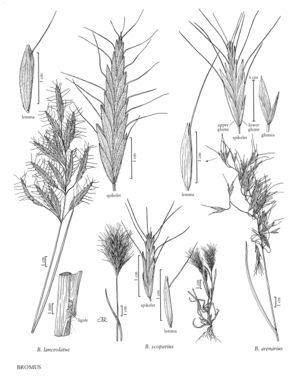Difference between revisions of "Bromus scoparius"
FNA>Volume Importer |
FNA>Volume Importer |
Revision as of 21:18, 16 December 2019
Plants annual. Culms (9)20-40 cm, erect or ascending. Sheaths sparsely pubescent or glabrous; ligules 0.8-1.5 mm, glabrous or hairy, obtuse; blades 5-20 cm long, 2-5 mm wide, abaxial surfaces glabrous, adaxial surfaces pilose. Panicles 2-7 cm long, 1-4 cm wide, erect, dense, obovoid, wedge-shaped at the base, sometimes interrupted; branches shorter than the spikelets, erect, straight or almost so, sometimes verticillate. Spikelets 12-25 mm, lanceolate, crowded, terete to moderately laterally compressed; florets 5-10, bases concealed at maturity; rachilla internodes concealed at maturity. Glumes scabrous to pubescent; lower glumes 3-4 mm, 3-5-veined; upper glumes 5-7 mm, 5-7-veined; lemmas 7-10 mm long, 1.5-2 mm wide, lanceolate, glabrous, obscurely 7-veined, rounded over the midvein, margins rounded, not inrolled at maturity, apices sharply acute, bifid, teeth shorter than 1 mm; awns 7-10 mm, flattened at the base, divaricate or recurved when mature, arising 1.5 mm or more below the lemma apices; anthers 0.3-0.5 mm. Caryopses shorter than the paleas, thin, weakly inrolled or flat. 2n = 14.
Distribution
N.Y., Calif., Mich., Va.
Discussion
Bromus scoparius is native to southern Europe. It grows in waste places. In the Flora region, it has been recorded from Californica and New York.
Selected References
None.
